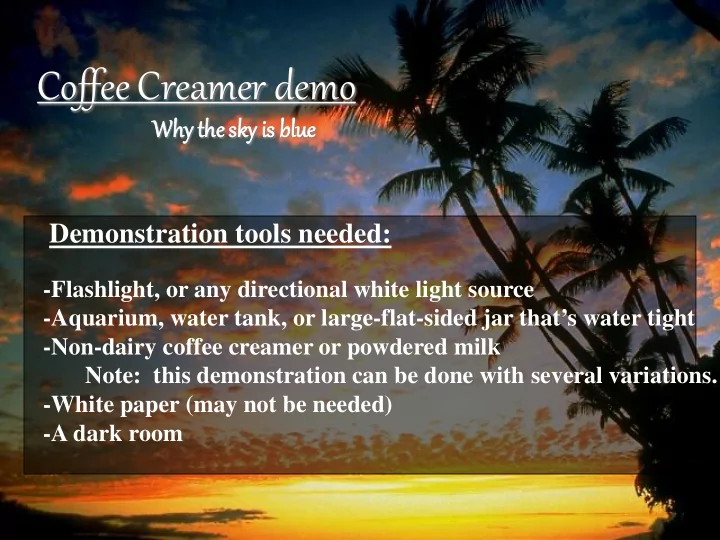

Coffee Creamer demo Why the sky sky i is blue Demonstration tools needed: -Flashlight, or any directional white light source -Aquarium, water tank, or large-flat-sided jar that’s water tight -Non-dairy coffee creamer or powdered milk Note: this demonstration can be done with several variations. -White paper (may not be needed) -A dark room
BASIC SETUP White light source Plain water Have the students look at the light through the water and notice that it still looks white. As they continue to look through the water at the source, begin to slowly poor the creamer through out the water, simulating molecules in the atmosphere, if you put too much, the light source will be completely blocked. (It’s recommended that this demonstration be practiced.)
Another variation of this experiment involves the mini-maglite and glue sticks. The concept is the same, but the medium through which the light is show is different. This time instead of the creamer in the water scattering the light, it’s the molecules in the glue sticks. Increasing the length of the glue sticks, i.e. placing them end to end, has the same affect as adding more creamer as in the original demonstration.
Look at the beam from the side of the tank and then from the end of the tank. You can also let the light project onto a white card, which you hold at the end of the tank. From the side, the beam looks bluish-white; from the end, it looks yellow-orange. If you have added enough creamer to the water, you will be able to see the color of the beam change from blue-white to yellow-orange along the length of the beam . Students standing at the far end of the tank should actually be able to watch the light source turn more reddish-orange in color as the creamer is added. This side should appear more red White light source Water Tank This side should appear dimmer and bluish Students standing sides of the tank should begin to see a blush color emerging. It may be helpful to use a white piece of paper as a sort of view screen along the sides to see the bluish tint.
* Here are some possible handouts/slides/or backgrounds that your chapter could use during a presentation. Don’t feel restricted in anyway and certainly don’t feel as if you have to use the available slides or pictures! Remember to use your creativity.
Note: Relative thickness of earth’s atmosphere is highly exaggerated. Sun rays The further that the light travels through the atmosphere, the more red it will appear to an observer looking toward the sun. This is because the blue light coming from the sun gets scattered at sharp angles by molecules in the atmosphere. As the light travels further through the atmosphere, less and less of the blue light gets through the atmosphere without being scattered at sharp angles. When an observer looks toward the sky, away from the sun, it appears blue because of the blue light that is being scattered around within the atmosphere.
Here’s a closer view…. This light appears more red because of Sun Rays the lack of blue light Observer at sunset looking toward the sun and through the atmosphere EARTH
A clear cloudless day-time sky is blue because molecules in the atmosphere scatter blue light from the sun at larger angles than they scatter red light. Blue light scattering off of molecules A person looking toward the sky will see blue light that is being scattered off of molecules in the atmosphere. When we look towards the sun at sunset we see red and orange colors because the blue light has been scattered at right angles, away from the line of sight toward the sun.
When we look towards the sun at sunset we see red and orange colors because the blue light has been scattered out and away from the line of sight.
Blank images for handouts or slides to use, simply click image and copy.
Recommend
More recommend